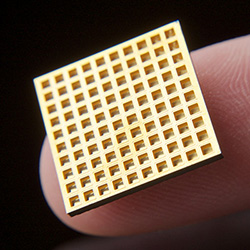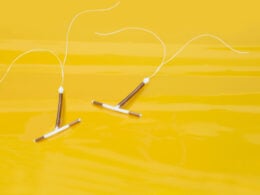Dear Bill Gates,
A few months ago you made the news with your support of a new microchip implant that would be placed in a woman’s body and function as a remote control contraceptive. The device, about a square inch and 3/8-inch thick, is inserted into the skin under local anesthesia. A wireless signal then begins triggering one of 200 micro-reservoirs to release a hormonal birth control drug on a pre-programmed dosing schedule. This device’s website boasts 16 years of reversible contraception, by far the longest acting and, in theory, the lowest maintenance form of contraception offered to date!
The wrong
The technology is indeed cutting edge. Your foundation is funding its development as part of a plan to provide contraceptives to 120 million women in the poorest countries in the world. Your intention is to bring reproductive justice and equality to these women. However, this plan is objectionable on a number of counts.
Hormonal contraceptives are powerful drugs that can and often will impact a woman’s body for the worst, increasing risks of cancer and blood clots, and affecting the moods and comfort of the patient with undesirable side effects. That’s also why so many women change formulation of hormonal contraceptives several times—there are at least 12 different molecules that can be used in a contraceptive’s formulation—before they find the one that is less problematic for them. That is, they switch when they have the assistance of a doctor who listens to them. I can’t imagine how this would work with an implant with a specific formulation. Would the doctor replace the implant to change a “combined formulation” to a “progesterone only formulation”? Even if the device allowed such customization, and even if the doctors could make the changes, which is highly unlikely in countries where access to doctors is so difficult in the first place, these women would still face the possibly severe side effects and increased risk of cancer and blood clots.
I would also have serious concerns about implanting a microchip, no matter how well tested, in my own body. In facts, we read stories of microchips placed in pets migrating and tumors developing when the body has a negative reaction to it. What will this look like with the human body? And are we really able to predict with any certitude the impact these implants will have?
Finally, a couple of sociological questions should really be our concern. One, you’re introducing a major disruption in the way these countries have functioned. Your western way of thinking, assuming that the problems of poverty and suffering are uniquely solvable by the introduction of technology, is completely questionable. Over and over, history shows that our unilateral interventions into a country’s culture, even with good intentions, can be very destructive.
Then there is the 1984 scenario, from which these countries are not immune. I am talking about a scenario where the government uses your technology to impose a certain policy on their people, or maybe to control and eliminate an undesired element in their country. It’s already happening in China on a large scale, with terrible abuses and dramatic consequences for the culture. With this invention, you could give the famously dictatorial government of Myanmar another tool to control their Muslim minority or that of Sudan to subversively call the fate of their Darfur population. Think about it.
The less wrong
Now, if you are determined to implant microchips into a human body, I have a suggestion. A woman has a well-designed cycle, with many subtle hormonal changes, triggering important natural functions, such as her periods, the secretion of a cervical fluid to facilitate a pregnancy when ovulation approaches, then ovulation, followed by a new hormonal change and then her period again.
One problem women have had is that they couldn’t know what was going to happen when. Women in general, including most women in developed countries, don’t know when they are fertile. But science has discovered the connection between the cycle’s key stages and internal signs, such as body temperature, hormone levels in the urine and the secretion of cervical mucus and changes in its consistency. Maybe there is a place for a microchip with sensors that can read these subtle changes and tell the woman where she’s at in the cycle and when she’s about to ovulate, so that she and her partner can choose whether or not to have intercourse.
This option offers a number of benefits over the previous idea: there are no hormones involved, so no risk of side effects or need to change formulation, and no increased risk of cancer or blood clots. The cultural change is less brutal: all you have added is knowledge and with it, the power of decision making.
There is less risk of governmental control or abuse, although data can always be collected against the will of the patients and misused. It’s still a foreign body that would come with its set of risks. The other problem with it is that it grossly underestimates women’s ability to learn and manage their own body’s signs.
The right
And that’s where we have a solution that you could easily facilitate with the millions of dollars you are pouring toward a potentially harmful technology. Doing so, you would turn a wrong into a right and still achieve your goal. The most advanced option today for women to have power of choice over their own reproduction is actually low-tech. Here it is: what about simply teaching women all over the world how to chart their natural cycles?
The technology required is very basic. In the case of the ovulation methods, it’s just learning to recognize the changes in the cervical fluid when it is secreted leading up to ovulation. In the case of the sympto-thermal method, a battery-operated $10 basal thermometer is needed, a pretty common device. Of course charting grids are involved, but paper and pens are fairly accessible everywhere in the world.
What’s fundamentally good with this approach is threefold: the knowledge women would acquire from learning to understand their bodies, the confidence and freedom that comes with this knowledge, and the ability to pass it on to the next generation.
It has been done. In the 1980s, Family of the Americas received a $1.6 million grant from US AID to provide such training. Their materials were translated into five languages and since then they have formed trainers in 100 countries, including in African and Asia. Their legacy is still visible.

A more recent initiative called CycleBeads developed by Georgetown University and embraced by a number of international organizations helps women know the most likely time of fertility. About 4.5 million women all over the world have learned it. The method doesn’t tell the women when they’re actually ovulating; it only helps them tell approximately when they could be fertile. Still it’s progress and much better than hormonal contraception. But there is more that women can learn. The ovulation and sympto-thermal methods are more effective because they help a woman know accurately and precisely when she ovulates. These methods are also already taught all over the world.
With proven methods, women anywhere in the world are able to understand how their bodies truly work, when they are ovulating and exactly when they’re fertile or not. Men need to be involved in the training so that they understand how their wives function and how they can participate in family planning decisions in a respectful way. Education is much safer than technology. It doesn’t demand dependency on exterior powers or organizations. It can be passed on from one generation to the next. It brings empowerment and true justice.
And that is right.
Be well,
Gerard Migeon












The human body, as our Biology tells us, is controlled physically primarily by hormones. Feeling of happiness for example is simply an increased concentration of dopamine and the similar hormones in our brain. Thus, in a purely biological point of view, such “controllable” and “programmable” release of hormones in a woman’s body is closer to slavery than freedom. Any non-theist should be able to recognize the level of control that such device is going to make to women. This kind of technology is more than one step backwards from women emancipation and freedom.